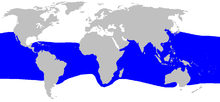Megamouth
| Megamouth shark | |
|---|---|
 |
|
| Scientific classification | |
| Kingdom: | Animalia |
| Phylum: | Chordata |
| Class: | Chondrichthyes |
| Subclass: | Elasmobranchii |
| Superorder: | Selachimorpha |
| Order: | Lamniformes |
| Family: |
Megachasmidae Taylor, Compagno & Struhsaker, 1983 |
| Genus: |
Megachasma Taylor, Compagno & Struhsaker, 1983 |
| Species: | M. pelagios |
| Binomial name | |
|
Megachasma pelagios Taylor, Compagno & Struhsaker, 1983 |
|
 |
|
| Range of megamouth shark (in blue) | |
| External identifiers for Megachasma pelagios | |
|---|---|
| ITIS | 159983 |
| NCBI | 57985 |
| WoRMS | 281542 |
| Also found in: | |
The megamouth shark (Megachasma pelagios) is a species of deepwater shark. It is rarely seen by humans and is the smallest of the three extant filter-feeding sharks alongside the whale shark and basking shark. Since its discovery in 1976, few megamouth sharks have been seen, with 63 specimens known to have been caught or sighted as of May 2017, including four recordings on film. Like the other two planktivorous sharks, it swims with its enormous mouth wide open, filtering water for plankton and jellyfish. It is distinctive for its large head with rubbery lips. It is so unlike any other type of shark that it is usually considered to be the sole extant species in the distinct family Megachasmidae, though suggestion has been made that it may belong in the family Cetorhinidae, of which the basking shark is currently the sole extant member. In addition to the living M. pelagios, however, two extinct megamouth species – the Priabonian M. alisonae and the Oligocene–Miocene M. applegatei – have also recently been proposed on the basis of fossilized tooth remains. However, the Cretaceous-aged M. comanchensis has been recently reclassified as an odontaspid shark in the genus Pseudomegachasma, and is in fact unrelated to the megamouth shark despite similar teeth morphology.
The appearance of the megamouth is distinctive, but little else is known about it. It has a brownish-black colour on top, is white underneath, and has an asymmetrical tail with a long upper lobe, similar to that of the thresher shark. The interior of its gill slits are lined with finger-like gill rakers that capture its food. A relatively poor swimmer, the megamouth has a soft, flabby body and lacks caudal keels. The megamouth is considerably less active than the other filter-feeding sharks, the basking shark and the whale shark. The megamouth has a stout body and a long, wide bulbous head.
...
Wikipedia

